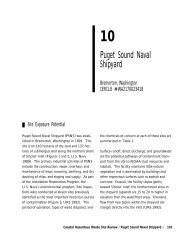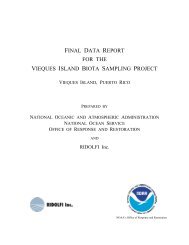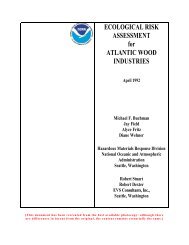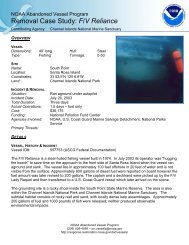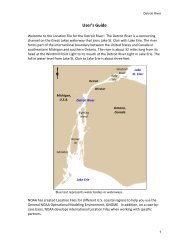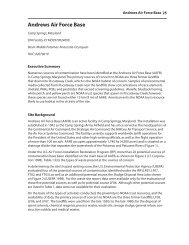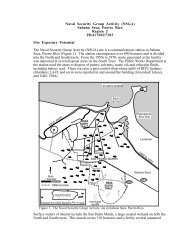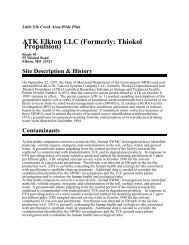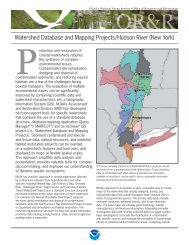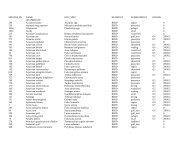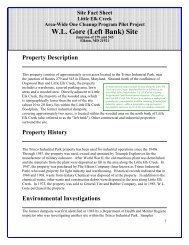The Coastal Resource Coordinator's Bioassessment Manual
The Coastal Resource Coordinator's Bioassessment Manual
The Coastal Resource Coordinator's Bioassessment Manual
Create successful ePaper yourself
Turn your PDF publications into a flip-book with our unique Google optimized e-Paper software.
HAZMAT 93-1–Toxicity Tests<br />
CHAPTER 3<br />
TOXICITY TESTS<br />
INTRODUCTION<br />
A toxicity test is a procedure that involves the exposure of organisms to complex<br />
environmental samples (water, sediment, or sediment extract) under controlled conditions<br />
to determine if adverse effects occur. Test samples usually contain unknown amounts of<br />
mixtures of contaminants. This procedure is sometimes referred to as a bioassay, but<br />
'toxicity test' is the more appropriate term because a bioassay is a test to determine the<br />
toxicity threshold of a specific substance, while this test is used to determine the toxicity of a<br />
whole sample, not its chemical components. Toxicity tests may be performed in the<br />
laboratory or with caged organisms in the field; however, protocols for in-situ toxicity tests<br />
are still in the developmental stage. Many organisms, from bacteria to mammals, have been<br />
used in such testing, and recently, toxicity tests using cell cultures and biomarker type<br />
indicators have been developed (see Chapter 2). <strong>The</strong>se tests measure a variety of organism<br />
responses (endpoints) to determine the toxic effects of substances on biological organisms.<br />
While the most commonly measured endpoint is death of the organisms, other endpoints<br />
frequently measured include developmental abnormalities, behavioral changes, changes in<br />
reproductive success, and alteration of growth. Although some programs also measure the<br />
bioaccumulation of contaminants at the end of toxicity testing, the use of bioaccumulation<br />
as an endpoint is not discussed in this chapter. Toxicity tests are becoming increasingly<br />
important in bioassessment, in part, because they are relatively inexpensive and numerous<br />
tests can be conducted quickly. Although the following discussion applies to toxicity testing<br />
in general, most of the emphasis is on sediment toxicity tests since these are often<br />
recommended at waste sites.<br />
Objectives of Toxicity Testing<br />
Toxicity tests put environmental chemical data into perspective by acting as a measure of<br />
bioavailability. <strong>The</strong>y can be used to document the extent of bioavailable contamination and<br />
to illustrate the potential for adverse effects at a waste site. Toxicity test results can be used<br />
early in the investigation of a site as a screening tool to indicate whether further<br />
bioassessment (for example, benthic community analyses) should be conducted. Results of<br />
toxicity tests can provide some information to indicate whether (and where) remediation<br />
should occur. Toxicity testing may help determine target levels for remediation. Results of<br />
toxicity tests alone will not be adequate for making remediation decisions; however, when<br />
3-1 August 1997




